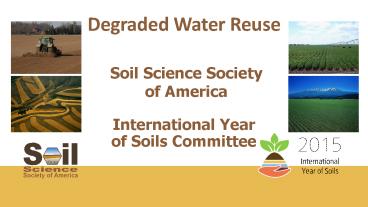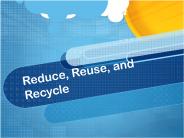Degraded Water Reuse - PowerPoint PPT Presentation
Title:
Degraded Water Reuse
Description:
... (The Immense Journey, 1957) What is ... Field-scale monitoring of the long-term impact and sustainability of drainage water reuse on the west side of California ... – PowerPoint PPT presentation
Number of Views:116
Avg rating:3.0/5.0
Title: Degraded Water Reuse
1
Degraded Water Reuse
Soil Science Society of America International
Year of Soils Committee
2
General Topics Covered
- Background
- - Definition of degraded water
- - Water uses and types of degraded water
- - Need for degraded water reuse
- Case study
- - Drainage water problem in the western San
Joaquin Valley (WSJV) - - Potential solution to problem
- - Impacts, ramifications, and sustainability
of drainage water reuse on - WSJV saline-sodic soil
3
If there is magic on this planet, it is
contained in water. - Loran Eisely (The
Immense Journey, 1957)
4
What is degraded water?
A degeneration of water quality following its
original intended use, where quality refers to
the condition of chemical and physical properties
such as, but not limited to, turbidity, pH,
salinity, pathogens, metals, nutrients, organics,
and temperature (Corwin and Bradford, 2008, JEQ
37S-1-S-7).
5
Most Common Water Uses
Agriculture
Domestic
Industry
Recreation
6
Common Types of Degraded Water
Agricultural runoff
Drainage from irrigation
Food processing wastewater
Industrial wastewater
Household grey water
Municipal wastewater
Urban stormwater
Confined animal feeding operations (CAFO)
wastewater
7
Global Water Availability(Past Trend)
From 1950 to 2000, the annual water availability
per person as calculated on a global basis
decreased from 16,800 m3 to 6800 m3 per year.
Shillomanov, I.A. 1997. Comprehensive assessment
of the freshwater resources of the world
Assessment of water resources and water
availability in the world. World Meteorological
Organization and Stockholm Environment Inst.,
Stockholm, Sweden.
8
Global Water Availability(Predicted Trend)
Estimates indicate that the worlds population
living in conditions of water stress will
increase from 41 in 1995 to 48 in 2025. World
Resource Institute. 2000. World resources
2000-2001 People and ecosystems The fraying web
of life. Oxford Univ. Press, New York.
9
Pollutants Degrading the Worlds Water Supplies
Pollutant Primary Sources Organic
matter Industrial wastewater and domestic
sewage Nutrients (e.g., NO3-N, P) Runoff from
agricultural lands and urban areas Heavy metals
(e.g., Hg, Cd, Zn, Pd, etc.) Industries and
mining Microbes (e.g., cholera, Giardia,
etc.) Domestic sewage, CAFOs, and natural
rources Toxic organics (e.g., oils, pesticides,
etc.) Wide variety of sources including
industrial sites, automobiles, farmers,
etc. Dissolved salts Leaching from agricultural
soils or drawn into costal aquifers from
overdrafting of ground water Acid precipitation
and acidic runoff Coal combustion and mining,
respectively Silt and suspended particles Soil
erosion and construction activities Thermal
pollution Dams and power plants (e.g., cooling
towers)
In general, pollution law and technologies have
been able to control point source pollution, like
factories and sewage treatment plants, but have
not been able to effectively reduce nonpoint
sources of pollution.
UNEP/GEMS (1995), Shiklomanov (1997), Taylor and
Smith (1997), and Revenga and Mock
(2001). Corwin, D.L., and S.A. Bradford. 2008.
Environmental impacts and sustainability of
degraded water reuse. J. Environ. Qual.
37S-1-S-7.
10
Degraded Water as an Alternative Water Resource
Today degraded waters are increasingly viewed as
potential alternative water sources due to the
increased demand on limited high quality water
resources, the increased occurrence of drought,
and the increased supply of degraded water.
Corwin, D.L., and S.A. Bradford. 2008.
Environmental impacts and sustainability of
degraded water reuse. J. Environ. Qual.
37S-1-S-7.
11
Degraded Water Reuse Case Study
Long-term sustainability of drainage water reuse
on the west side of Californias San Joaquin
Valley (WSJV)
12
Why is drainage water reuse needed in
Californias WSJV?
- Recurring drought and urban water demands stress
current freshwater supplies to the point where an
alternative water source is needed - Drainage water is a disposal problem in WSJV
- Reason closure of Kesterson Reservoir in mid
1980s as a drainage water disposal site due to
the discovery of deformities in water fowl found
to be associated with Se in drainage water - 340,000 ha adversely affected by shallow water
tables in WSJV, but no place to dispose of
drainage water - Currently, evaporation ponds are used for
drainage water but for every 10 ha of drained
land, 1 ha is needed for the evaporation pond,
which takes land out of productivity
13
Solution to Drainage Water Disposal Problem
Drainage Water Reuse
- Drainage water is a potential means of reclaiming
non-productive saline-sodic soils in WSJV - 1.7 million ha are highly saline (gt 6 dS/m)
and/or sodic (ESPgt15). - Proposed solution
- Use saline drainage water on marginally
productive, saline-sodic soils to grow salt
tolerant forage to support livestock as a means
to (1) reduce drainage water volumes, (2) reclaim
saline-sodic soils, (3) return lands to
productivity, and (4) provide an alternative
water resource for irrigation. - Concerns regarding drainage water reuse
- Sustainability
- Spatio-temporal impacts on soil and crop
yield/quality
14
Monitor Spatio-temporal Changes due to Drainage
Water Reuse
- Objective Monitor spatial and temporal changes
during reclamation of a saline-sodic soil with
3-5 dS/m drainage water.
15
Monitor Spatio-temporal Changes due to Drainage
Water Reuse
- Objective Monitor spatial and temporal changes
during reclamation of a saline-sodic soil with
3-5 dS/m drainage water. - Study site 32.4-ha saline-sodic field within
Westlake Farms.
California
USA
Westlake site
Kings County
16
Monitor Spatio-temporal Changes due to Drainage
Water Reuse
- Objective Monitor spatial and temporal changes
during reclamation of a saline-sodic soil with
3-5 dS/m drainage water. - Study site 32.4-ha saline-sodic field within
Westlake Farms. - Study period 1999-2011. Only data from 1999-2004
is shown because most significant changes
occurred during this time period.
August 1999
17
Monitor Spatio-temporal Changes due to Drainage
Water Reuse
- Objective Monitor spatial and temporal changes
during reclamation of a saline-sodic soil with
3-5 dS/m drainage water. - Study site 32.4-ha saline-sodic field within
Westlake Farms. - Study period 1999-2011. Only data from 1999-2004
is shown because most significant changes
occurred during this time period. - Chemical parameters monitored due to their
influence on the quantity and quality of yield of
a salt-tolerant forage crop (i.e., Bermuda
grass) Salinity (ECe or electrical conductivity
of the saturation extract), sodium (SAR or sodium
adsorption ratio), B, and Mo.
18
Temporal Change of Field Means by
Depth (1999-2004)
- ECe 11 decrease
- SAR 11 decrease
- B 21 decrease
- Mo 56 decrease
19
Spatio-temporal Change in ECe
- ECe increased with depth and decreased over time.
- Leaching caused ECe to decrease over time,
particularly in top 0.6 m and in the north. - Salinity accumulated in the south below 60 cm.
20
Spatial Gain Loss in ECe
indicates significant difference from 1999 to
2004
21
Spatio-temporal Change in SAR
0-0.3 m
0.3-0.6 m
0-0.3 m
0.3-0.6 m
0-0.3 m
0.3-0.6 m
0.6-0.9 m
0.9-1.2 m
0.6-0.9 m
0.9-1.2 m
0.6-0.9 m
0.9-1.2 m
1999
2002
2004
- ECe and SAR patterns are quite similar.
- Leaching decreased SAR over time, particularly in
top 0.6 m and in the north. - Na accumulated in the south below 60 cm.
22
Spatial Gain Loss in SAR
indicates significant difference from 1999 to
2004
23
Spatio-temporal Change in B
0-0.3 m
0.3-0.6 m
0-0.3 m
0.3-0.6 m
0-0.3 m
0.3-0.6 m
0.6-0.9 m
0.9-1.2 m
0.6-0.9 m
0.9-1.2 m
0.6-0.9 m
0.9-1.2 m
1999
2002
2004
- Leaching of B over time, particularly in top 0.6
m and in the north.
24
Spatial Gain Loss in B
indicates significant difference from 1999 to
2004
25
Spatio-temporal Change in Mo
0-0.3 m
0.3-0.6 m
0-0.3 m
0.3-0.6 m
0-0.3 m
0.3-0.6 m
0.6-0.9 m
0.9-1.2 m
0.6-0.9 m
0.9-1.2 m
0.6-0.9 m
0.9-1.2 m
1999
2002
2004
- Leaching of Mo over time through entire profile
(0-1.2 m).
26
Spatial Gain Loss in Mo
indicates significant difference from 1999 to
2004
27
Potenial Se Buildup
28
Spatial Change in pHe
indicates significant difference from 1999 to
2004
29
Prognosis
Field site was non-productive in 1999. By 2004
the application of drainage water to the
saline-sodic field improved soil quality,
supporting a forage crop with 100 head of
livestock.
March 2004
5-year results show the reuse of 3-5 dS/m
drainage water reclaimed saline-sodic soil and
brought marginally productive land back into
production.
Westlake site south end
30
Positive Ramifications of Drainage Water Reuse
on Saline-Sodic Soil
- Reclamation of saline-sodic soil
- ECe leached from top 1.2 m, especially 0-0.6 m
- Na leached from top 1.2 m, especially 0-0.6 m
- B leached from top 0.6 m
- Mo leached from top 1.2 m
- Reduced drainage volumes thereby reducing land
set aside for evaporation ponds - Returned marginally productive land back to
productivity - Provided an alternate water source
31
Potential Negative Impacts
- Evidence of accumulation of Se in the north.
- Increasing pH in the south, particularly at lower
depths (below 60 cm) - NOTE The accumulation of salt, Na, and B below
60 cm in the south is a consequence of the
dispersion of clay by Na, creating a zone of low
permeability. Appling a Ca amendment in the south
and leaching will rectify this problem.
32
Caveat
Even though the reuse of drainage water on WSJV
saline-sodic soil results in many positive
effects, intermittent monitoring of Se and pH is
advisable.
33
Suggested Reading
General degraded water reuse Asano, T., F. L.
Burton, H. L. Leverenz, R. Tsuchihashi, and G.
Tchobanoglous. 2007. Water Reuse Issues,
Technologies, and Applications by McGraw Hill,
New York, NY. Corwin, D. L., and S. A.
Bradford. Environmental impacts and
sustainability of degraded water reuse. J.
Environ. Qual. 37S-1 S-7. 2008. Monitoring
the long-term impact and sustainability of
drainage water reuse Corwin, D. L., S. M.
Lesch, J. D. Oster, and S. R. Kaffka. Monitoring
management-induced spatio-temporal changes in
soil quality with soil sampling directed by
apparent soil electrical conductivity.
Geoderma. 131369-387. 2006. Corwin, D.L.
2012. Field-scale monitoring of the long-term
impact and sustainability of drainage water reuse
on the west side of Californias San Joaquin
Valley. J. Environ. Monit. 141576-1596.
34
- The UN Declared 2015 as the International Year of
Soils (IYS) to bring more attention to this
important natural resource. The Soil Science
Society of America celebrates IYS and is happy to
bring you this presentation. We hope you take the
time to learn more about soils at the many
resources listed at the end of this presentation,
as you learn more about how - Soils Sustain Life
35
Thank you for listening!For further information,
visit
- Soils.org/discover-soils information about all
things soil! - Soils4teachers.org Lesson plans, activities,
etc. for teachers - Soils4kids.org activities for the K-12 audience
- Follow us on facebook.com/iheartsoil
- Soils sustain life!































